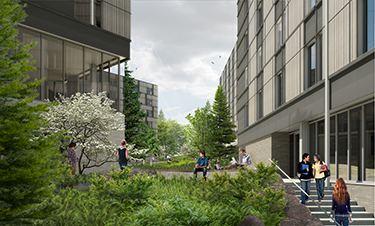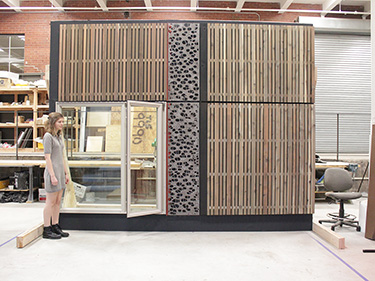|
Subscribe / Renew |
|
|
Contact Us |
|
| ► Subscribe to our Free Weekly Newsletter | |
| home | Welcome, sign in or click here to subscribe. | login |
Construction
| |
 |
November 16, 2017
Designers use a prototype to keep UW dorm project on budget
KieranTimberlake

Feaster
|
The University of Washington’s North Campus housing project extends the campus fabric by creating a new network of student residential buildings and intimate, memorable outdoor spaces.
Scheduled to open in 2018, the three buildings that make up the project’s first phase will provide nearly 1,800 student beds and a host of residential community amenities. Prior to designing these buildings, KieranTimberlake had worked on UW’s extended North Campus master plan and thus already had a sound understanding of the buildings’ massing strategy.
But with a combined facade area of over 215,000 square feet, the project’s success hinged on developing engaging facades that maintained visual interest across a large scale. Physical prototyping consequently became an essential part of the design’s evolution as we began thinking of how to artfully compose and carefully detail these buildings while remaining within the university’s budget.
Mixing materials
Our research into successful housing precedents on UW’s West Campus pointed our team to the five-over-two building typology that’s omnipresent across Seattle.
We began our design process with this building type in mind, envisioning designs that provided visual interest and broke down the project’s large scale. During our early concept iteration, we kept coming back to the idea of a multi-material facade: Cladding the buildings’ lower floors in brick and concrete would keep them well-grounded and help them relate to the surrounding existing campus buildings, while cladding the upper wood-framed floors in cedar would make the facade more engaging and allow each level to reflect its construction typology.
Driven by the idea of a multi-material exterior and inspired by patterning found in historic Pacific Northwest basketry, we realized that a layered rain screen would be a cost-effective way to add depth to the facade.
This notion intrigued us because, much like the basketry patterns, a rain screen facade could key in on the idea that ornament need not be additive, but instead could be a product of the buildings’ construction methodology and assembly. Additionally, a rain screen facade system would hold up well over time and would protect the building envelope within Seattle’s climate.
The site’s microclimate and cedar’s natural properties meant the rain screen boards demanded daylight and ventilation in order to prevent unsightly staining and keep the boards resistant to the moss, lichen and other biogrowth that thrives in Seattle’s wet climate. As a result, we knew our facade design should avoid shaded overhangs directly over the cedar and maintain enough space between individual boards to allow for sufficient airflow.
The design also needed to incorporate flashings that would keep water from sitting on any cut ends while allowing for movement within the wood-framed floors.
The rain screen met all of these needs for most of the building’s exterior, although there were some areas where a predominantly metal facade made more sense.
Constructing prototypes
Despite the abundance of technology readily at our fingertips during the design process, there is something to be said for setting the computer aside and physically testing and iterating ideas.
Of the architectural work we do in our firm, we find that prototyping early in the design process — typically early in the design development phase — allows us to better understand a design’s particular nuances.
There is an important distinction between “prototyping” and using “mockups”: Mockups tend to be written into specifications and are intended to be contractor-led projects that vet installation and technique as part of, and usually just prior, to construction. In contrast, our goal in prototyping is to reveal real-world construction and assembly challenges that might otherwise go unnoticed until a project’s construction.
By prototyping in the design development phase, our team can make observations with enough time for our reactions and adjustments to inform a design’s evolution, and without the undue consequences of change orders, schedule implications or other unexpected construction-phase issues.
For the University of Washington, our team of architects built facade prototypes in-house and reviewed them with the university team at our Philadelphia studio, rather than on campus. After our design concept had taken shape but before all of its details had been sorted out, we hosted our client contingent, their consultants, and the project’s general contractor and construction manager for a day of meetings.
Rather than present the conventional design slides and models, this meeting was held in our workshop with a 1:1 scale prototype of the conceived facade as the centerpiece. This prototype allowed us to readily engage all project stakeholders in aesthetic discussions and decisions such as cedar board size, reveal joint spacing, accent color selections and metal fin depth. Equally important, however, was that the prototype allowed us to have these aesthetic discussions in parallel with technical discussions relating to flashing dimensions, gauge, slope and detailing.
As a result of such a hands-on meeting, all parties came away from the design process feeling confident that the finalized North Campus housing facade design is successful and cost-effective.
On our part, we know that the design is better for having naturally engaged in this type of study early in the design process. The benefits inherent in this type of early engagement make us excited for the future of the industry, which continues to move toward integrated project delivery and design-build delivery models.
We have seen this trend developing firsthand as more and more of our clients express interest in pursuing alternative design models, and our experiences with the opportunities these processes provide make us optimistic for future. We should all welcome the chance to front-load construction and assembly detail prototyping within the design process, and should also look to involve more builders, subcontractors, trade partners and all those who will actually be constructing our designs in the field.
David Feaster is an architect and associate with KieranTimberlake.
Other Stories:
- 9 Douglas firs will be installed as art in new Life Sciences Complex
- Computer science building aims to be a home away from home
- Troy Hall rehab shows why universities like design-build
- WSU art museum a crimson ‘jewel box’ in the heart of campus
- Tacoma Paper & Stationery channels UWT’s urban vibe
- UW's utility plant is meant to be seen
- WSU: Top 10 capital projects
- UW: Top 10 capital projects
- WSU branch in Everett will prepare students for STEM careers




